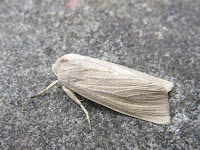Keith Jones, from Undy, sent me this photo and fascinating email.
On the 16th of August I noticed that my pond, which a few days before had been covered with duckweed, was almost completely clear of the plant. On looking more closely I noticed a number of tubes that appeared to be made out of duckweed leaves and these tubes were moving slowly about on the surface of the water although there was no wind to cause the movement, meaning that there was something in the tubes causing the motion.
At first I thought of Caddis fly larvae that build tubes to hide in but I thought they usually crawled about on the pond bottoms not on the surface. I didn't do any more about the puzzle of what the tubes were at once but a few weeks later I read that Small China-mark larvae fed on duckweed and then a few weeks later still I looked the moth up on ukmoths and discovered that the larvae build little tubes - so the mystery was solved.
Checking the two photographs I took at the time of parts of my small pond (c 2m by 1.5m) I counted over 150 of the tubes so there must have been well over 300 in total!
At first I thought of Caddis fly larvae that build tubes to hide in but I thought they usually crawled about on the pond bottoms not on the surface. I didn't do any more about the puzzle of what the tubes were at once but a few weeks later I read that Small China-mark larvae fed on duckweed and then a few weeks later still I looked the moth up on ukmoths and discovered that the larvae build little tubes - so the mystery was solved.
Checking the two photographs I took at the time of parts of my small pond (c 2m by 1.5m) I counted over 150 of the tubes so there must have been well over 300 in total!
This was followed soon after by an email from Keith discussing both the abundance of Cataclysta larvae and their subsequent rapid disappearance:
A few days after I took the photographs of the tubes I noticed that most of them had gone, which I assumed was due to a number of possible reasons
- they had been predated
- they had pupated
- they had all died through lack of food
- or a combination of these
Under normal circumstances, in say a reen or ditch full of duckweed, the larvae would be hidden from view munching away at the duckweed leaves while camouflaged by their tubes.
In the case of my pond, however, there may have been so many larvae that they had eaten all the limited amount of duckweed leaving their tubes out in the open in plain view where I happened to spot them.
So which of my possible reasons for their subsequent disappearance is the correct one?
I rule out the first because there are no fish in my pond which might eat them although there could be some other predator.
I'd like to think it was the second one but that it was most likely the third one with any surviving larvae scavenging the tubes of the others until all were gone, or....



















